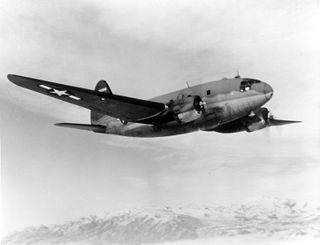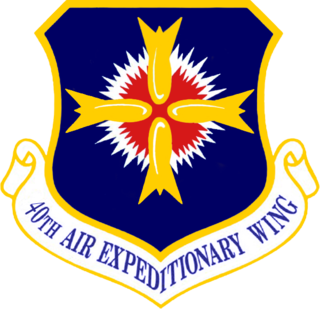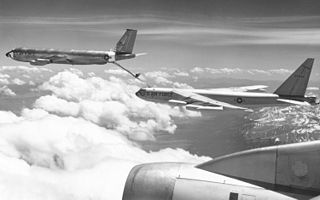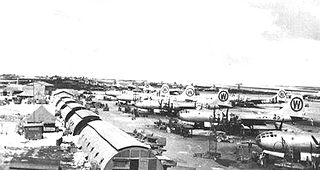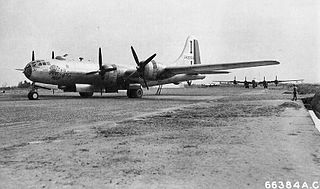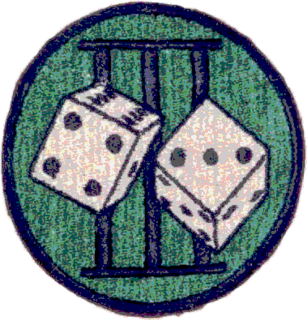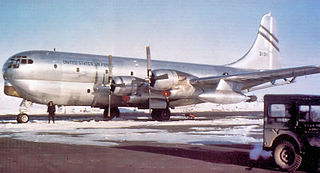303d Air Refueling Squadron  | |
|---|---|
Boeing KC-97G Stratofreighter as flown by the squasdron | |
| Active | 1943; 1943-1946; 1951-1952; 1953-1963 |
| Country | |
| Branch | |
| Role | Air Refueling |
| Part of | Strategic Air Command |
| Motto(s) | Every Man a Tiger |
| Engagements | China Burma India Theater Pacific Ocean theater of World War II |
| Decorations | Distinguished Unit Citation |
| Insignia | |
| Patch with early 303d Air Refueling Squadron emblem |  |
| Patch with later 303d Air Refuleing Squadron emblem |  |
The 303d Air Refueling Squadron is an inactive United States Air Force unit. It was last assigned to the 499th Air Refueling Wing at Kindley AFB, Bermuda, where it was inactivated on 15 June 1963.

The United States Air Force (USAF) is the aerial and space warfare service branch of the United States Armed Forces. It is one of the five branches of the United States Armed Forces, and one of the seven American uniformed services. Initially formed as a part of the United States Army on 1 August 1907, the USAF was established as a separate branch of the U.S. Armed Forces on 18 September 1947 with the passing of the National Security Act of 1947. It is the youngest branch of the U.S. Armed Forces, and the fourth in order of precedence. The USAF is the largest and most technologically advanced air force in the world. The Air Force articulates its core missions as air and space superiority, global integrated intelligence, surveillance, and reconnaissance, rapid global mobility, global strike, and command and control.

The 499th Air Refueling Wing is an inactive United States Air Force (USAF) unit that was last active at Westover AFB, Massachusetts in June 1966.
Contents
- History
- Flying the Hump
- B-29 Superfortress operations against Japan
- Strategic Air Command
- Lineage
- Assignments
- Stations
- Aircraft
- Awards and Campaigns
- References
- Notes
- Bibliography
- External links
The squadron was first active as the 303d Transport Squadron, an airlift element of the India-China Wing, Air Transport Command. The 303d flew missions over the Hump before being disbanded when Air Transport Command abandoned the traditional squadron and group organization for its operations in the China Burma India Theater.

A squadron in air force, army aviation, or naval aviation is a unit comprising a number of military aircraft and their aircrews, usually of the same type, typically with 12 to 24 aircraft, sometimes divided into three or four flights, depending on aircraft type and air force. Land based squadrons equipped with heavier type aircraft such as long-range bombers, or cargo aircraft, or air refueling tankers have around 12 aircraft as a typical authorization, while most land-based fighter equipped units have an authorized number of 18 to 24 aircraft.

An airlift is the organized delivery of supplies or personnel primarily via military transport aircraft.
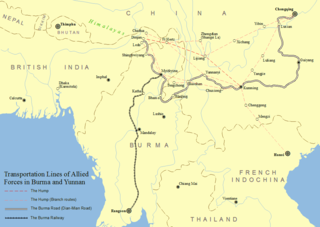
The Hump was the name given by Allied pilots in the Second World War to the eastern end of the Himalayan Mountains over which they flew military transport aircraft from India to China to resupply the Chinese war effort of Chiang Kai-shek and the units of the United States Army Air Forces (AAF) based in China. Creating an airlift presented the AAF a considerable challenge in 1942: it had no units trained or equipped for moving cargo, and no airfields existed in the China Burma India Theater (CBI) for basing the large number of transports that would be needed. Flying over the Himalayas was extremely dangerous and made more difficult by a lack of reliable charts, an absence of radio navigation aids, and a dearth of information about the weather.
The second predecessor of the squadron was the 483d Bombardment Squadron, a very heavy Boeing B-29 Superfortress squadron that flew missions from Tinian against Japan before moving to the Philippines, where it was inactivated in 1946.

The Boeing B-29 Superfortress is a four-engine propeller-driven heavy bomber designed by Boeing, which was flown primarily by the United States during World War II and the Korean War. It was one of the largest aircraft operational during World War II and featured state-of-the-art technology. Including design and production, at over $3 billion it was the single most expensive weapons project in World War II, exceeding the $1.9 billion cost of the Manhattan Project—using the value of dollars in 1945. Innovations introduced included a pressurized cabin, dual-wheeled, tricycle landing gear, and an analog computer-controlled fire-control system directing four remote machine gun turrets that could be operated by a single gunner and a fire-control officer. A manned tail gun installation was semi-remote. The name "Superfortress" continued the pattern Boeing started with its well-known predecessor, the B-17 Flying Fortress. Designed for the high-altitude strategic bomber role, the B-29 also excelled in low-altitude nighttime incendiary bombing missions. One of the B-29's final roles during World War II was carrying out the atomic bomb attacks on Hiroshima and Nagasaki.
The unit was activated a third time as the 303d Air Refueling Squadron, and served during the Cold War to support Strategic Air Command bombers. For most of its active life, the squadron operated from a forward base in the middle Atlantic to support reflex deployments and maintained readiness to support Emergency War Order missions.

The Cold War was a period of geopolitical tension between the Soviet Union with its satellite states, and the United States with its allies after World War II. A common historiography of the conflict begins with 1946, the year U.S. diplomat George F. Kennan's "Long Telegram" from Moscow cemented a U.S. foreign policy of containment of Soviet expansionism threatening strategically vital regions, and ending between the Revolutions of 1989 and the 1991 collapse of the USSR, which ended communism in Eastern Europe. The term "cold" is used because there was no large-scale fighting directly between the two sides, but they each supported major regional conflicts known as proxy wars.

Strategic Air Command (SAC) was both a United States Department of Defense (DoD) Specified Command and a United States Air Force (USAF) Major Command (MAJCOM), responsible for Cold War command and control of two of the three components of the U.S. military's strategic nuclear strike forces, the so-called "nuclear triad," with SAC having control of land-based strategic bomber aircraft and intercontinental ballistic missiles or ICBMs.
In 1985, the United States Air Force consolidated three squadrons, but they have not been active since the consolidation.



